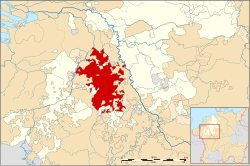House of Jülich
| Duchy of Jülich | ||||||||||
|
Herzogtum Jülich (de) Hertogdom Gulik (nl) |
||||||||||
| State of the Holy Roman Empire | ||||||||||
|
||||||||||
|
Map of the Lower Rhenish–Westphalian Circle around 1560,
Duchy of Jülich highlighted in red |
||||||||||
| Capital | Jülich | |||||||||
| Languages | Ripuarian | |||||||||
| Government | Principality | |||||||||
| Historical era | Middle Ages, Renaissance | |||||||||
| • | Gerhard I, first count | c. 1003 | ||||||||
| • | Raised to duchy | 1356 | ||||||||
| • | United with Berg | 1423 | ||||||||
| • | United with Cleves and Berg |
1521 | ||||||||
| • | Held by Palatinate-Neuburg |
1614 | ||||||||
| • | Annexed by France | 1794 | ||||||||
| • | To Prussia and Netherlands | 1815 | ||||||||
|
||||||||||
The Duchy of Jülich (German: Herzogtum Jülich; Dutch: Hertogdom Gulik; French: Duché de Juliers) comprised a state within the Holy Roman Empire from the 11th to the 18th centuries. The duchy lay left of the Rhine river between the Electorate of Cologne in the east and the Duchy of Limburg in the west. It had territories on both sides of the river Rur, around its capital Jülich – the former Roman Iuliacum – in the lower Rhineland. The duchy amalgamated with the County of Berg beyond the Rhine in 1423, and from then on also became known as Jülich-Berg.
Its territory lies in present-day Germany (part of North Rhine-Westphalia) and in the present-day Netherlands (part of the Limburg province), its population sharing the same Limburgish dialect.
The first count in the Jülichgau of Lower Lorraine, Gerhard I, was mentioned in 1003; his grandson Gerhard III began to call himself Count of Jülich in 1081. William IV, who became count in 1219, significantly enlarged the territory and in 1234 granted Jülich town privileges, provoking the Cologne Archbishop Konrad von Hochstaden, whose troops devastated the city five years later. William IV's son Walram (Count from 1278 to 1297) remained a fierce opponent of the Bishopric, supporting Duke John I of Brabant at the 1288 Battle of Worringen against Archbishop Siegfried II of Westerburg. Though Walram's younger brother Count Gerhard V had sided with German king Adolf of Nassau against his rival Albert I of Habsburg, he managed to retain his territories after Adolf of Nassau lost the Battle of Göllheim in 1298, and in 1314 supported the coronation of Louis IV of Wittelsbach at the nearby City of Aachen, once more against the will of the Cologne bishop. The long-time conflict came to an end when Gerhard's younger son Walram became Archbishop of Cologne in 1332. His elder brother Count William V in 1336 received the title of a margrave from Emperor Louis IV, and in 1356 Emperor Charles IV of Luxembourg raised William V to the rank of duke. His son Duke William II, however, became entangled in a fierce feud with the Emperor's half-brother Wenceslaus of Luxembourg, Duke of Brabant, whom he defeated at the Battle of Baesweiler in 1371.
...
Wikipedia


